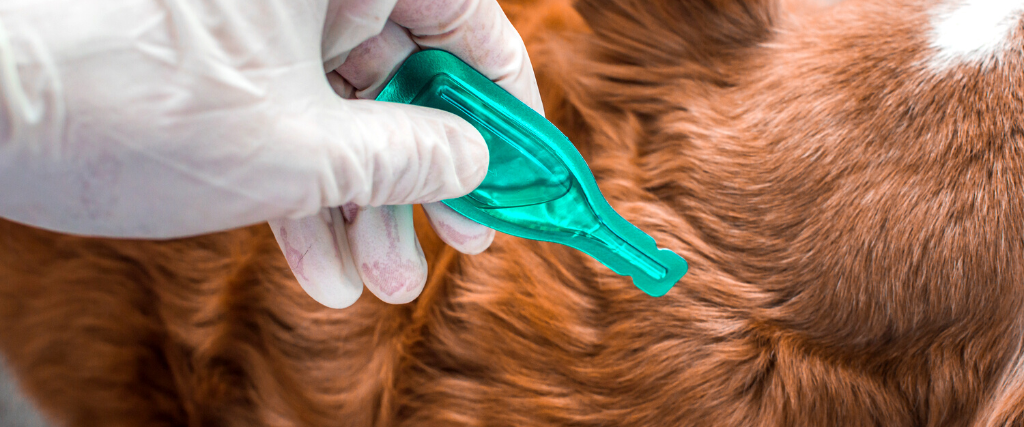Itchy skin is one of the most common presenting symptoms at our animal hospitals around the county.
Treating itchy skin in dogs and cats, eliminate skin parasites
FLEAS: If your dog is suffering from allergies, adding fleas or mange mites to his misery will make him doubly miserable. Save your poor, beloved pooch that agony, and buy some awesome flea stuff from your veterinarian (nothing over the counter or natural remedy will truly help a dog or cat with a flea allergy).
MANGE: Your vet may also consider a second prescription drug to treat and prevent mange mites during the diet trial, to make sure no other parasites get involved and complicate the plan (we like oral ivermectin for this). Most veterinarians will perform regular skin scraping tests during the 8 week trial to examine for these mange mites.
RINGWORM: A fungal infection that infests hair follicles, ringworm is usually treated with oral antifungals and topical shampoo. Ringworm is contagious to humans, which is why we rule it out on visit #1.

Treating itchy skin in dogs and cats, Dust Mites and Inhalant Allergy Testing & Desensitization
Assuming you have successfully completed your 8 week elimination diet trial and either your dog remained itchy throughout the trial, or challenging her with her old diet did not make her itchy, now you're left with either atopy or dust mite allergy.
Alternatively called Hay Fever or seasonal allergies, atopy has no known cure, but can be managed. Our management vehicle of choice is allergy desensitization.
Along with food allergies, dust mite allergies are the second most common cause of winter allergies and itchy skin seen at our Indianapolis veterinary clinic.
Dust mite allergy FUN FACT #1!
A pet that has scabies (true "mange" mites) will test positive for dust mites.
Dust mite allergy FUN FACT #2!
Dust mites are the leading cause of allergies and asthma in humans, and more dogs and cats are allergic to dust mites than to fleas.
Where do dust mite allergies come from?
Dust mites prefer warm and humid environments, so allergies to dust mites are worst in the fall, when homes are closed up because of cool evenings and increased humidity.
Dust mites prefer mattresses, upholstery, carpeting and fabrics. So while you may find more visible dust in other areas of your home (on bookshelves, inside air ducts for instance) mites actually prefer to hide out in darker and more protected environments. Cleaning out your vents and dusting the shelves probably do very little to reduce dust mites; a visibly clean home is not necessarily lower in allergens.
Pet bedding, pet toys, and finished basements are dust mite magnets.
Because true avoidance of dust mites is not practical, most veterinarians direct treatment at minimizing dust mite allergens in the home, and desensitizing the pet to the mite allergen.

Top 10 Ways To Minimize Dust Mites and Indoor Allergies in your home
- Keep your pet out of the bedroom. Dust mites love mattresses, pillows, and pet beds, so keeping them in rooms with the least humidity or fabric is best. If that is not possible, wash bed linens at least weekly in hot water, and use allergen-proof covers on your bed and pillows. Special note: no feather pillows! If this is not possible, Use a HEPA vacuum in the room, and run a HEPA air filter near the bed when the room isn't occupied.
- Buy a vapor steam cleaning machine. Vapor contains only 5-6% water, so the vapor doesn't contribute to a moist environment. Vapor steam deeply penetrates whatever it is cleaning, and it is great for upholstery, couches, carpets, and mattresses.
- Replace pet beds and human pillows at least every six months, and cover the ones you have with allergen-proof covers.
- Eliminate wall-to-wall carpet, get washable throw rugs instead. (or at least keep the pets off the carpet) Wood, seamless vinyl or linoleum floor coverings are best because they can be cleaned frequently. If this is not possible, steam cleaning a carpet reduces 87% of the dust mites.
- Launder or replace stuffed toys weekly. If this is not possible, consider freezing stuffed toys in the freezer (in a tightly closed plastic bag), and shake vigorously outside after removing them from the freezer.
- Use air conditioning or central heat, plus dehumidifiers if needed, to keep household humidity low. Change furnace filters frequently.
- Keep pets out of closets (dark, humid)
- Minimize humidity-increasing houseplants.
- Do not confine your dog to the laundry room, bathroom, utility room or basement or other high humidity part of the home.
- Choose your furnishings wisely. When possible, choose: Closed bookshelves and curios instead of open shelves; Washable curtains instead of blinds and heavy draperies; Furniture with simple designs instead of ornately curved pieces; Easily cleaned decorations instead of dried flowers or straw; Wooden or plastic furniture instead of upholstery.
Veterinary treatment of itchy skin caused by seasonal allergies or dust mites
Primary therapy for dust mite allergies in pets is similar to that of inhalant allergies.
Here is how allergy testing and desensitization works:
- First, establish a list of what your pet is allergic to, either using a panel of blood allergens from your veterinarian, or a trip to a local veterinary dermatology specialist.
- Second, give your pet ever increasing doses of whatever she is allergic to, either by daily drops under her tongue, or via injections.
Allergy testing and desensitization appears to be helpful in about 80% of patients receiving the treatments, at reducing the length and severity of allergy attacks throughout the pet's lifetime.
If your pet is itchy and unsure where to start, contact us today to schedule an appointment. We will help to get your pet relief from what pests are bugging them.
Allergies are never cured, only managed.



